How to Bathe a Dog ? A Step-by-Step Guide
Bathing your dog is an essential part of their grooming routine. Keeping your furry friend clean can help prevent skin infections, fleas, ticks, and other health issues. While some dogs love to take a bath, others may find it stressful. In this article, we will guide you through the process of bathing your dog and provide you with some tips and tricks to make it a more enjoyable experience for both you and your pup.
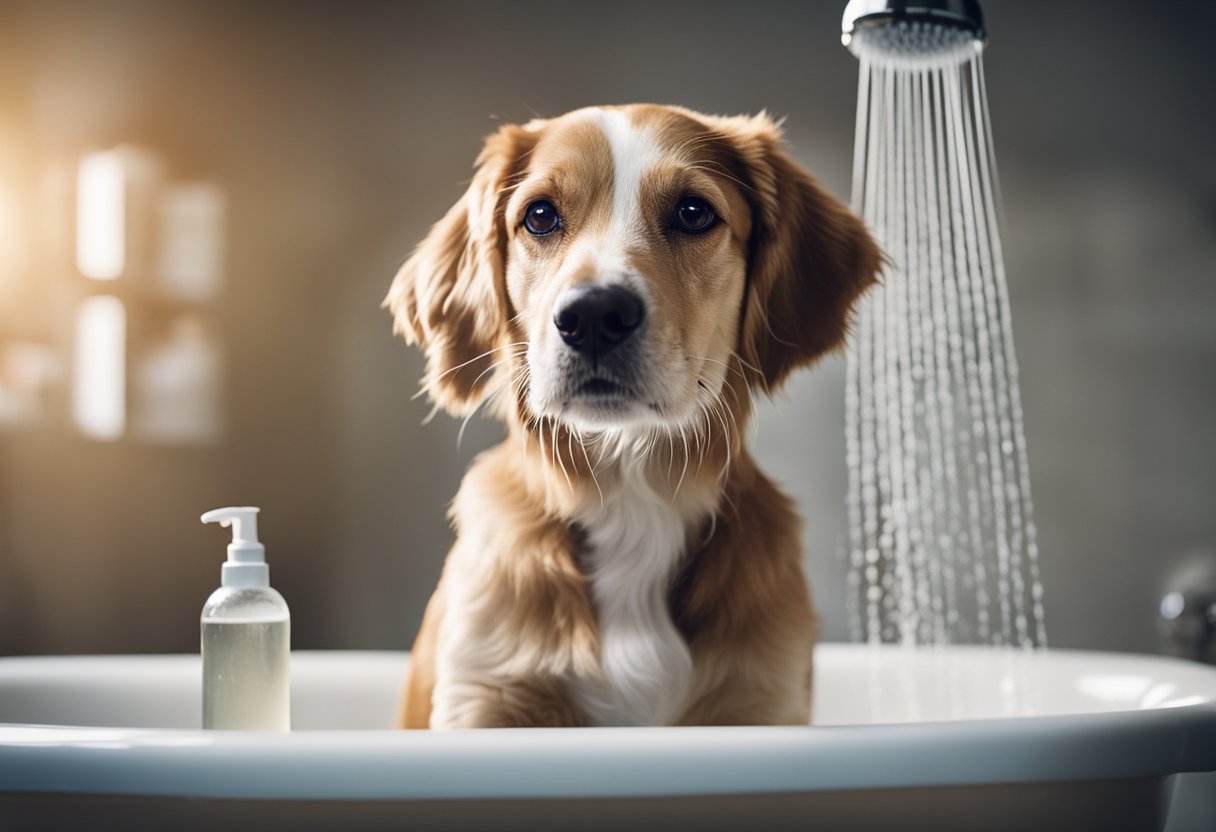
Before you start bathing your dog, it’s important to prepare everything you will need. This includes a dog shampoo, towels, a brush, and a non-slip mat. It’s also a good idea to trim your dog’s nails before the bath and brush their coat to remove any tangles or mats. Additionally, you should choose a location that is warm, well-lit, and easy to clean, such as a bathtub or a large sink.
Once you have everything ready, it’s time to start bathing your dog. The process may vary depending on your dog’s breed, coat type, and size. However, there are some general steps you can follow to make it easier. These include wetting your dog’s coat thoroughly, applying shampoo, rinsing thoroughly, and drying your dog with towels. Remember to be gentle and avoid getting water or shampoo in your dog’s eyes, ears, and nose.
Key Takeaways
- Preparing everything you need before bathing your dog can make the process smoother and more enjoyable for both you and your pup.
- Following a general bathing process can help you avoid getting water or shampoo in your dog’s sensitive areas.
- Bathing your dog regularly is important to prevent skin infections, fleas, ticks, and other health issues.
Preparing for the Bath
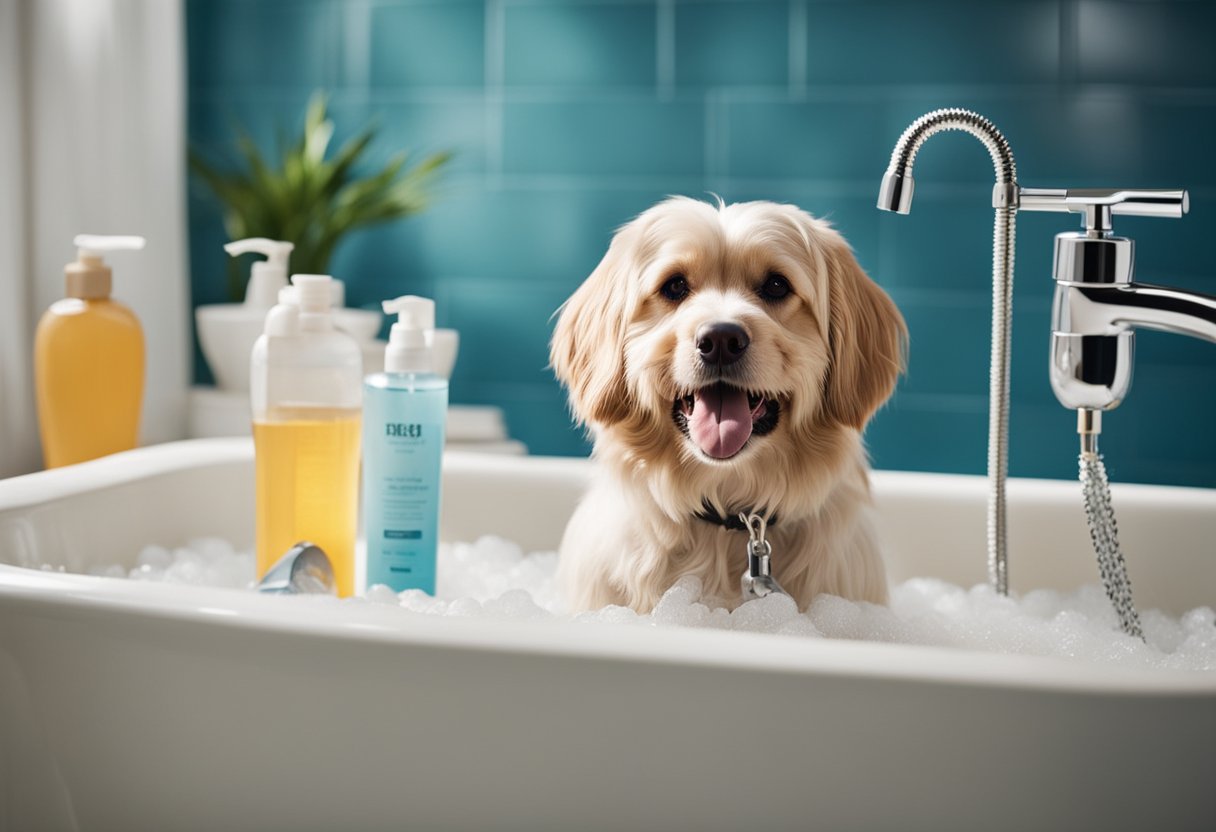
Before you start bathing your dog, it’s important to gather all the necessary supplies. This will help you avoid any interruptions during the bath and ensure that the process goes smoothly.
Gather Supplies
Here are some of the supplies you’ll need to bathe your dog:
- Dog shampoo (make sure it’s safe for dogs and not human shampoo)
- Towels (one for drying your dog and one for cleaning up any mess)
- Brush or comb (to remove any mats or tangles in your dog’s coat)
- Cotton balls (to clean your dog’s ears)
- Treats (to reward your dog for good behavior)
Choose the Right Location
When it comes to bathing your dog, you’ll want to choose a location that is easy to clean and has good drainage. A bathtub or shower with a handheld sprayer is ideal, but if you don’t have access to one, you can use a large plastic tub or even a kiddie pool.
It’s also important to make sure the room is warm and free from any drafts. This will help keep your dog comfortable during the bath.
Brush the Dog
Before you start the bath, it’s a good idea to brush your dog’s coat to remove any loose hair, dirt, or mats. This will help make the bath more effective and prevent any tangles from getting worse.
Use a brush or comb that is appropriate for your dog’s coat type. For example, a slicker brush is good for dogs with long, curly hair, while a bristle brush is better for short-haired breeds.
By taking the time to prepare for the bath, you can help ensure that the process goes smoothly and your dog stays happy and comfortable.
Bathing Your Dog
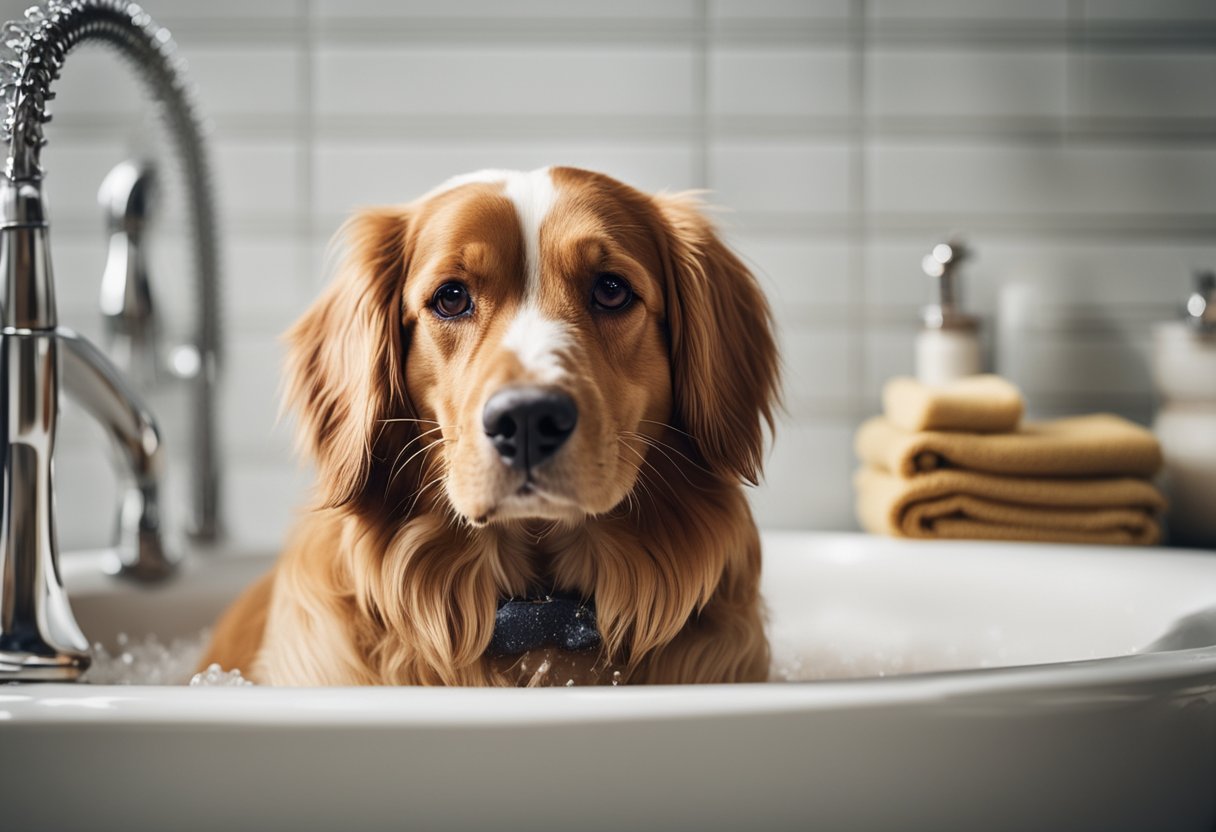
Bathing your dog is an essential part of their grooming routine. It helps keep their coat shiny and healthy, and also helps prevent skin problems. Here are the steps you should follow to give your dog a proper bath.
Wet the Dog
Before you start washing your dog, make sure you wet their coat thoroughly. Use lukewarm water to avoid burning their skin. You can use a hose or a showerhead to wet your dog’s coat. Start at the back and work your way up to their head. Be careful not to wet their face, as this can make them uncomfortable.
Apply Shampoo
Once your dog is wet, it’s time to apply shampoo. Use a dog-specific shampoo, as human shampoo can be too harsh for their skin. Apply the shampoo to your dog’s coat and work it in with your hands. Make sure you cover all areas of your dog’s body, including their legs, belly, and tail. If your dog has a thick coat, you may need to apply more shampoo.
Rinse Thoroughly
After you’ve applied the shampoo, it’s time to rinse your dog thoroughly. Use lukewarm water to rinse your dog’s coat, starting at the head and working your way down to their tail. Make sure you rinse all the shampoo out of their coat, as leftover soap can cause skin irritation.
Dry the Dog
Once your dog is rinsed, it’s time to dry them off. Use a towel to pat your dog’s coat dry. If your dog has a thick coat, you may need to use a blow dryer on a low setting. Make sure you don’t use a high heat setting, as this can burn your dog’s skin. If your dog is afraid of the blow dryer, you can use a towel to dry them off completely.
By following these steps, you can give your dog a proper bath and help keep their coat healthy and clean. Remember to use dog-specific shampoo, and to rinse your dog thoroughly to avoid skin irritation.
Resources
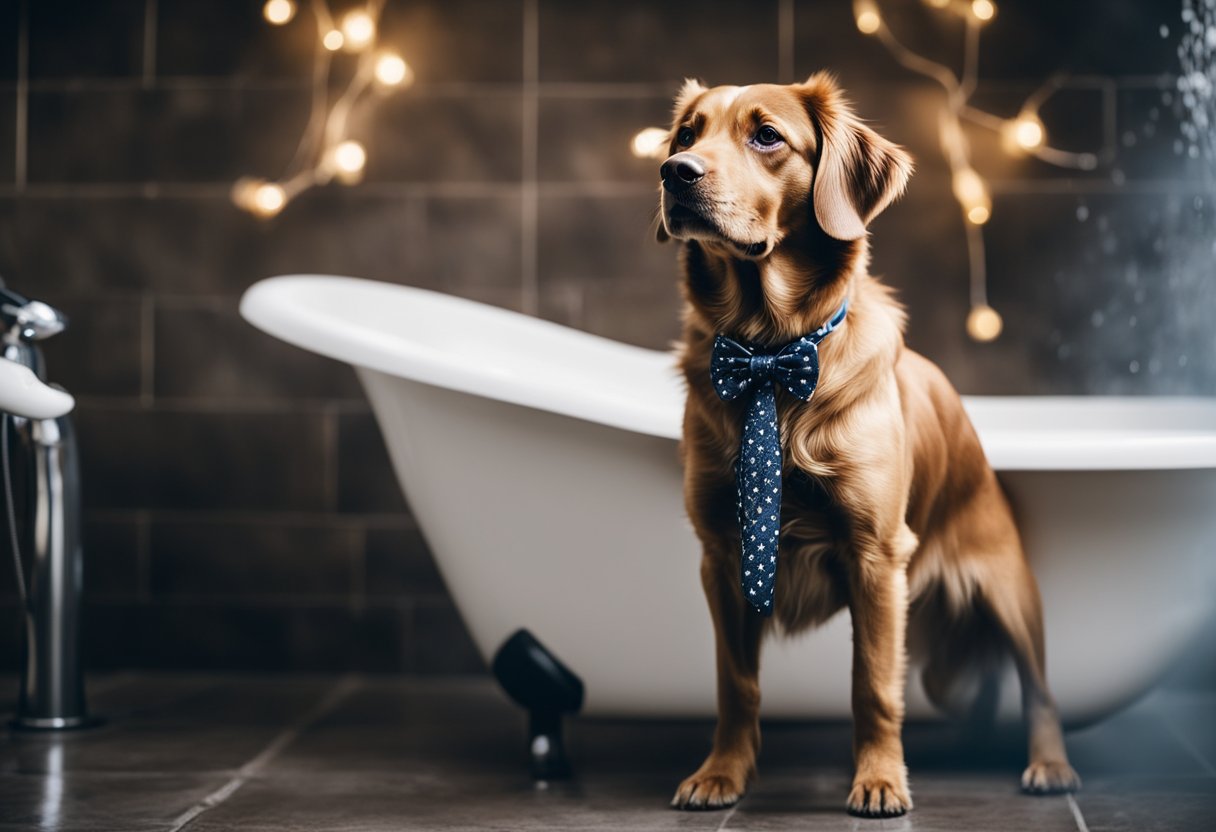
When it comes to bathing your dog, there are a lot of resources available to help you get the job done right. Here are a few useful resources to check out:
- The American Kennel Club has a great article on how to safely give your dog a bath. They cover everything from choosing the right shampoo to drying your dog off afterwards.
- Betterpet also has a helpful guide on how to bathe a dog, according to veterinarians. They provide step-by-step instructions on how to prepare for the bath, how to wet your dog’s coat, and how to apply shampoo.
- If you’re looking for some product recommendations for dog shampoo and other grooming supplies, Temu has a wide selection of pet supplies at affordable prices. They offer free shipping and returns for new users.
- Preventive Vet has some additional tips for bathing your dog at home, including how to avoid getting water in your dog’s ears and how to rinse your dog thoroughly.
Overall, with the right resources and a little bit of practice, bathing your dog can be a stress-free and enjoyable experience for both you and your furry friend.
Conclusion

Bathing your dog can be a fun and bonding experience for both you and your furry friend. It’s important to remember that every dog is different and what works for one may not work for another. However, by following the basic steps and tips outlined in this guide, you can make bath time a stress-free and enjoyable experience for both you and your dog.
To summarize, here are some key takeaways:
- Always use lukewarm water and test the temperature before bathing your dog.
- Use a shampoo specifically designed for dogs and avoid getting it in their eyes, ears, and nose.
- Be gentle when lathering and scrubbing your dog’s coat, and pay extra attention to areas that are prone to dirt and grime.
- Rinse your dog thoroughly to ensure all shampoo is removed, and use a towel to dry them off.
- Reward your dog with treats and praise to make bath time a positive experience.
By following these simple steps, you can keep your dog clean and healthy while also strengthening your bond with them. Remember to always prioritize your dog’s comfort and well-being, and don’t hesitate to seek advice from a veterinarian if you have any concerns.
Frequently Asked Questions
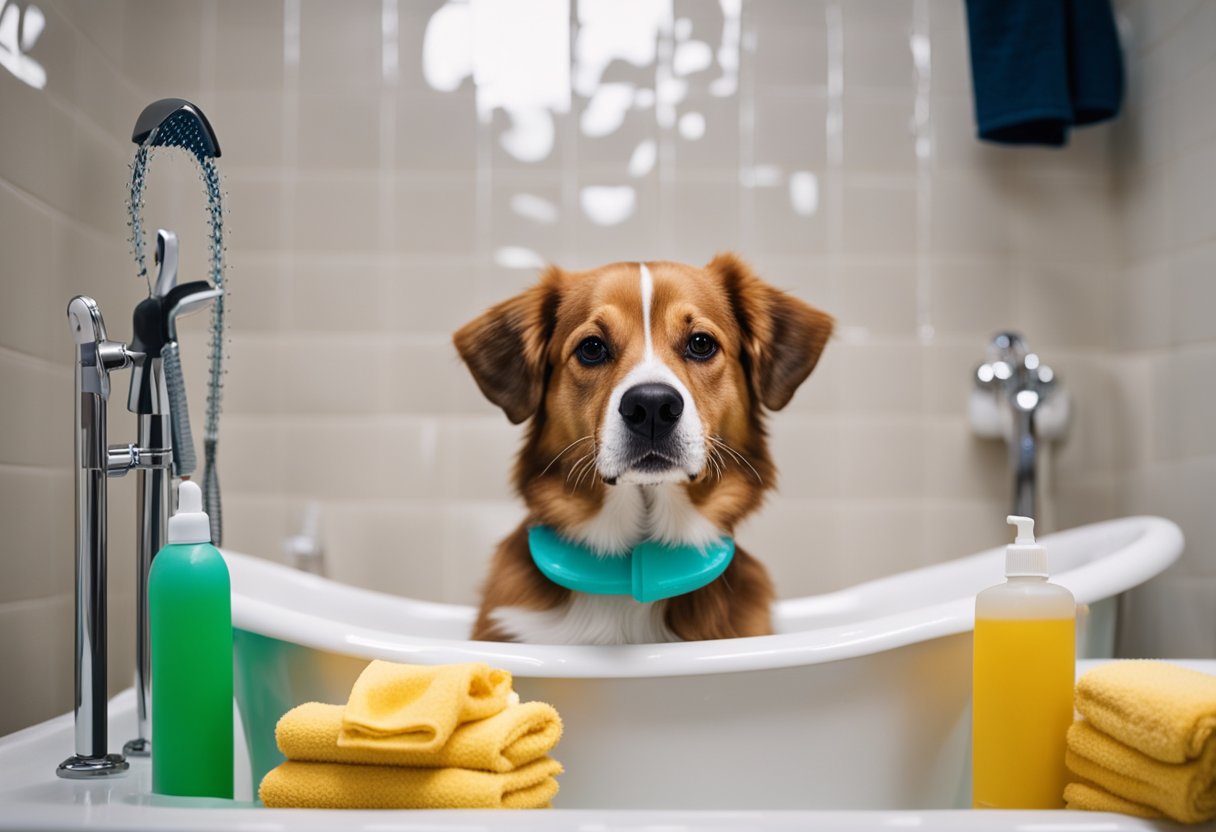
What is the best way to bathe a dog in a bathtub?
When bathing your dog in a bathtub, it’s important to make sure the water temperature is lukewarm and not too hot or cold. Wet your dog’s coat from the rear forward, slowly working your way up to your dog’s face. Be careful to never pour water directly over your dog’s head. Use a dog-specific shampoo and work from the neck down to the tail, being sure to rinse thoroughly.
How can you bathe a dog that is resistant to water?
If your dog is resistant to water, try using a handheld showerhead or a cup to pour water over their body instead of immersing them in a tub of water. You can also try using a treat to distract them or a non-slip mat to make them feel more secure.
What are some effective methods for washing a dog without a bathtub?
If you don’t have a bathtub, you can use a large sink or a kiddie pool to bathe your dog. You can also use a hose outside if the weather is warm enough. Be sure to use a dog-specific shampoo and rinse thoroughly.
Can you outline the steps to properly bathe a dog at home?
To properly bathe a dog at home, follow these steps:
- Brush your dog’s coat to remove any tangles or mats.
- Prepare a basin of lukewarm water.
- Wet your dog’s coat from the rear forward.
- Use a dog-specific shampoo and work from the neck down to the tail.
- Rinse thoroughly.
- Towel dry your dog or use a blow dryer on a low setting.
What techniques do groomers use to bathe dogs?
Groomers use a variety of techniques to bathe dogs, including using a handheld showerhead or a hose, using a non-slip mat to make the dog feel more secure, and using a dog-specific shampoo. They also use a variety of tools, such as brushes and combs, to help remove tangles and mats.
How do you safely give a dog a bath in the shower?
To safely give a dog a bath in the shower, make sure the water temperature is lukewarm and not too hot or cold. Wet your dog’s coat from the rear forward, slowly working your way up to your dog’s face. Be careful to never pour water directly over your dog’s head. Use a dog-specific shampoo and work from the neck down to the tail, being sure to rinse thoroughly.
